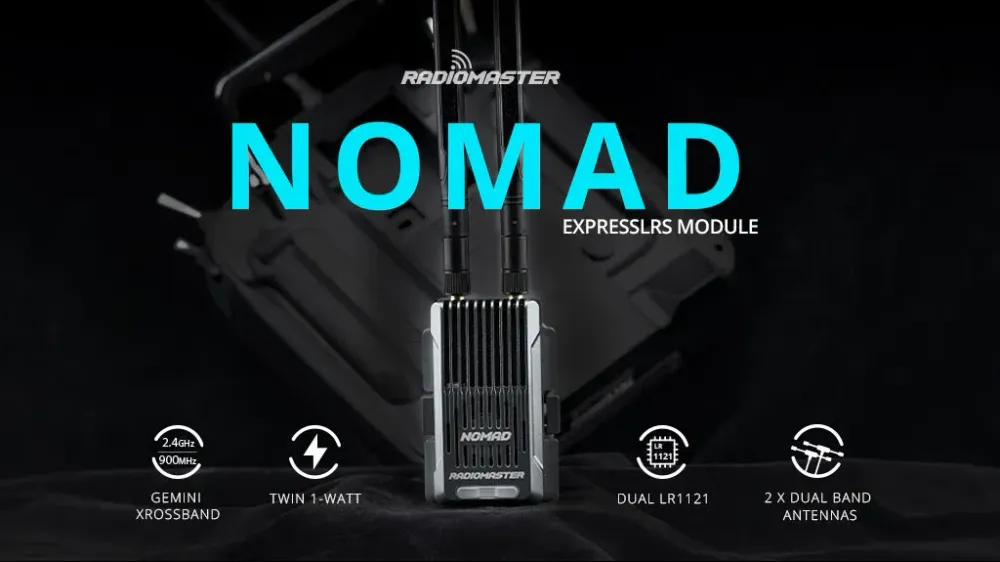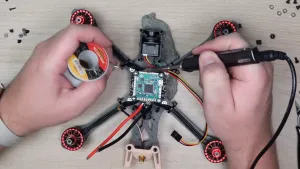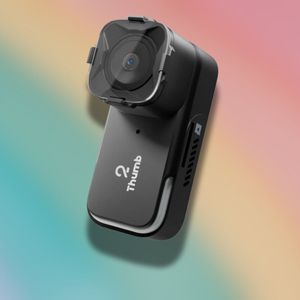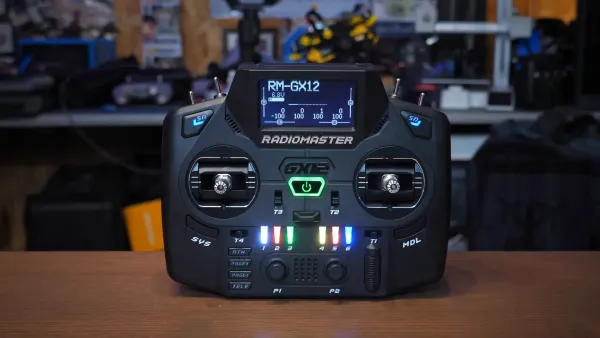The Radiomaster Nomad is becoming known, as a flexible ExpressLRS module designed for drone fans. Its dual band functionality and cutting edge features ensure top notch performance in different flying situations.
2.4 GHz or 868/900 MHz? Why Not Both?
The discussion about whether to use the 2.4 GHz or 868/900 MHz frequency bands in ExpressLRS is still happening. Each band has its own advantages and disadvantages. The 2.4 GHz band can send packets quickly reaching a speed of 1,000 packets per second which means less delay. On the hand the 900 MHz band is better at going through obstacles and covering distances making it suitable, for flights or navigating tricky environments.
Although 868/900 MHz offers benefits it can't compete with the speed of 2.4 GHz and needs antennas. The ease of use of 2.4 GHz antennas makes them simpler to install. But what if you didn't have to pick one over the other? What if a dual band transmitter could effortlessly function in both frequency bands enhancing performance and dependability? This is exactly where the Radiomaster Nomad steps in.

What is Gemini?
Gemini technology is revolutionizing the world of ExpressLRS modules. With its use of antennas and dual radio systems it offers a communication link. This means that each packet can be sent twice boosting the likelihood of successful data transfer in tough conditions.
The use of method not improves dependability. Also extends range, in areas where signal quality might start to weaken. What sets the Radiomaster Nomad apart is its compatibility with Gemini technology on both the 2.4 GHz and 868/900 MHz frequency bands, offering unmatched versatility.

What Makes the Nomad Unique
What sets the Radiomaster Nomad apart is its ability to integrate both 2.4 GHz and 868/900 MHz functionalities into a single module. This feature provides users with the versatility to toggle between frequency bands based on their specific preferences. Whether you're involved in racing or undertaking long range journeys the Nomad is capable of adjusting to your needs without the hassle of swapping out hardware.
It Supports Both JR and Lite Form Factor
Moreover the Nomads design features a JR module bay and a nano module adapter allowing for different types of radios. This versatility ensures compatibility, with setups making it user friendly. This allows it to be used in radio systems ranging from setups to smaller configurations. With adapters provided for both formats users can easily integrate the Nomad into their existing gear.

Background on Packet Rates
Grasping packet rates is crucial, for enhancing your ExpressLRS experience. Packet rates determine the frequency at which signals are transmitted from the transmitter to the receiver. A lower packet rate allows for range and penetration. However it comes with increased latency.
On the hand increasing packet rates can decrease latency but may impact range and penetration abilities. The Radiomaster Nomad provides options, for rates that suit various flying preferences whether it's high speed racing or extended distance flights.
2.4 GHz Packet Rates
The Radiomaster Nomad operates, in the 2.4 GHz frequency range offering packet rates suited for purposes. Users have the flexibility to choose from options such as 50 Hz, 100 Hz and even up to 500 Hz. Each rate strikes a balance between response time and signal range. This adaptability in packet rates empowers pilots to personalize their flying experience according to specific flight requirements.
For instance a racer may choose a packet rate to reduce latency while a long range pilot might opt for a rate to enhance range and signal penetration. The versatility of the Nomad allows pilots to discover the balance that aligns with their preferred flying techniques.

868/900 MHz Packet Rates
Historically the 868/900 MHz spectrum has had constraints, on packet speeds. However the Radiomaster Nomad is set to revolutionize that with its introduction of packet rates such as 50 Hz, 100 Hz and an impressive 250 Hz all of which were once beyond reach in this frequency range.
With this progress users can now experience the advantages of 868/900MHz frequency while maintaining low latency. The dual radio configuration empowers the Nomad to extend these packet speeds boosting performance.
2.4 GHz and 868/900 MHz at the Same Time: What's the Point?
One of the notable aspects of the Radiomaster Nomad is its ability to utilize both 2.4 GHz and 868/900 MHz frequencies at the same time. This functionality allows users to send packets across frequencies enhancing backup and dependability.
In scenarios where interference could be an issue this functionality enables pilots to select the optimal signal without the need for band switching. For instance encountering a tower or Wi Fi hotspot during flight may lead to disturbances. The ability to switch bands automatically ensures that the pilot stays in control despite faced with obstacles.

The Radiomaster Nomad isn't an ExpressLRS module; it's a game changer for drone lovers. With its capability to operate on both 2.4 GHz and 868/900 MHz frequencies and its Gemini technology it offers performance and adaptability. Whether you're into racing, adventuring or just having fun in the air the Nomad has all the features you need.
Future Packet Rates
The future potential, for packet rates in the Radiomaster Nomad looks promising. With the upcoming release of ExpressLRS 3.5 users can anticipate improvements such as the addition of packet rates in both frequency bands.
In other words if you're looking, for latency the Nomad is set to offer communication soon solidifying its position as a strong player in the world of racing.
This Module Does It All!
The Radiomaster Nomad lives up to the saying "it can do everything." With its capability to effortlessly switch between 2.4 GHz and 868/900 MHz frequencies users can adjust to flying scenarios without needing extra modules. This versatility is particularly advantageous for pilots who participate in both racing and long distance flying.
The Nomad offers the thrill of 2.4 GHz speed while providing the flexibility to switch to 868/900 MHz for coverage. This versatility is essential for drone enthusiasts.
What Receiver Do You Need?
To make the most of what the Radiomaster Nomad has to offer its important to choose the receiver. The ideal choice is a dual band receiver that can function on both the 2.4 GHz and 868/900 MHz bands. This will enable you to fully leverage the Nomads Gemini technology, which relies on a receiver that can decode transmissions across both frequencies simultaneously.
If you have a band receiver the Nomad can still work well for you even though you won't get all the advantages of Gemini. Just make sure your receiver is compatible, with the frequency band you intend to use.

The First Dual-Band Full-Diversity Receiver: Radiomaster DBR4
The Radiomaster DBR4 receiver represents an advancement, in drone technology. Being the dual band full diversity receiver it comes equipped with four antennas—two operating at 2.4 GHz and two at 868/900 MHz—ensuring signal reception across both frequency ranges.
This receiver is built to integrate with the Radiomaster Nomad offering the advantages of Gemini technology. Together they promise enhanced range, dependability and overall efficiency across flying scenarios.

BaycKRC Did It First
It's worth noting that although the Radiomaster DBR4 represents progress the idea of receivers was initially pioneered by BaycKRC. Their groundbreaking design featured a dual band antenna that could function on both 2.4 GHz and 868/900 MHz frequencies though it had some performance drawbacks when compared to specialized antennas.
The introduction of the BaycKRC receiver opened up opportunities, for innovations such as the DBR4 showcasing the increasing need for adaptable solutions within the FPV community. With advancements in technology it will be intriguing to observe how these progressions impact upcoming designs and functionalities.

Let's See It Work on a Spectrum Analyzer!
To fully understand what the Radiomaster Nomad can do using a spectrum analyzer for testing is essential. It provides users with a view of how both frequency bands are performing at time. By keeping an eye on the 2.4 GHz and 868/900 MHz bands users can see how the Nomad responds to varying packet rates and interference situations.
Observing the Nomad performance, through a spectrum analyzer validates its capability to sustain a signal under circumstances offering reassurance to users who test their gear to the max.

A Few Last Issues
The Radiomaster Nomad may have impressive features but there are factors to consider. The dual band antennas, though convenient may not offer the same level of performance as specialized antennas designed for each frequency. When configuring their systems serious racers and long range hobbyists should take this aspect into account.
Moreover the modules power output is limited to one watt. Although this is sufficient for purposes some users may seek higher output levels for extended distances. Nevertheless for a majority one watt offers power, for efficient communication.
Is This the Ultimate ELRS Module?
The Radiomaster Nomad is a top contender, for the best ELRS module. Its features such as dual band functionality, Gemini technology and compatibility with receivers make it an essential asset for drone hobbyists.
Whether you're speed flying, adventuring or filming stunning drone shots the Nomad is packed with features to elevate your flying journey. With technology progressing the Nomad is ready to adjust and grow ensuring it's a smart choice for dedicated pilots.








